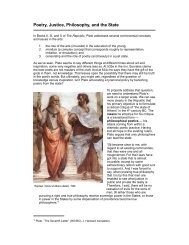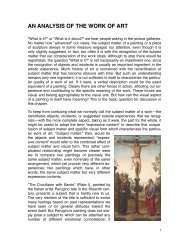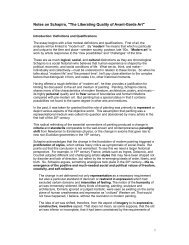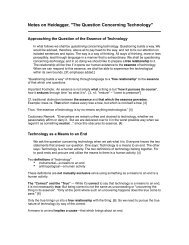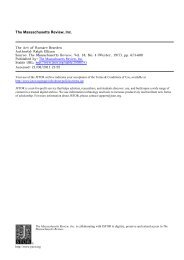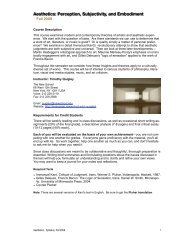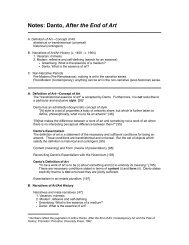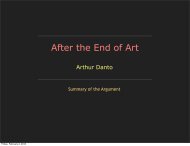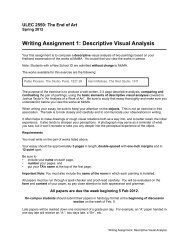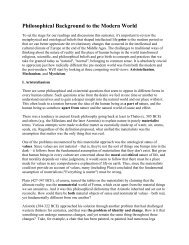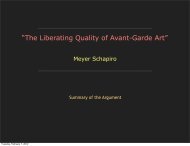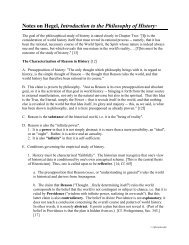This strikes me as comparable toNietzsche's notion of the artist in hisDionysian mode as vehicle for thatwhich is expressed through him in awilling self-abnegation. [??]The actions most proper to him—those gestures, those tracings of which he alone iscapable <strong>and</strong> which will be revelations to others because they do not lack what he lacks—to him they seem to emanate from the things themselves, like figures emanating from theconstellations.Inevitably the roles between the painter <strong>and</strong> the visible switch. That is why so manypainters have said that things look at them. As Andre March<strong>and</strong> says, after Klee: "In aforest, I have felt many times over that it was not I who looked at the forest. Some days Ifelt that the trees were looking at me, were speaking to me…. I was there, listening…. Ithink that the painter must be penetrated by the universe <strong>and</strong> not want to penetrate it…. Iexpect to be inwardly submerged, buried. Perhaps I paint to break out."[9]We speak of "inspiration," <strong>and</strong> the word should be taken literally. There really isinspiration <strong>and</strong> expiration of Being, respiration in Being, action <strong>and</strong> passion so slightlydiscernible that it becomes impossible to distinguish between who sees <strong>and</strong> who is seen,who paints <strong>and</strong> what is painted. We say that a human being is born the moment whensomething that was only virtually visible within the mother's body becomes at once visiblefor us <strong>and</strong> for itself. The painter's vision is an ongoing birth.In paintings themselves we could seek a figured philosophy[10] of vision—itsiconography, perhaps. It is no accident, for example, that frequently in Dutch paintings(as in many others) an interior in which no one is present is "digested" by the "round eyeof the mirror".[11] This prehuman way of seeing things is emblematic of the painter's way.More completely than lights, shadows, <strong>and</strong> reflections, the mirror image anticipates,within things, the labor of vision. Like all other technical objects, such as tools <strong>and</strong> signs,the mirror has sprung up along the open circuit between the seeing <strong>and</strong> the visible body.Every technique is a "technique of the body," illustrating <strong>and</strong> amplifying the metaphysicalstructure of our flesh. The mirror emerges because I am a visible see-er, because there isa reflexivity of the sensible; the mirror translates <strong>and</strong> reproduces that reflexivity. In it, myexternality becomes complete. Everything that is most secret about me passes into thatface, that flat, closed being of which I was already dimly aware, from having seen myreflection mirrored in water. Schilder observes that, smoking a pipe before a mirror, I feelthe sleek, burning surface of the wood not only where my fingers are but also in thoseotherworldly fingers, those merely visible ones inside the mirror.[12] The mirror's phantomdraws my flesh into the outer world, <strong>and</strong> at the same time the invisible of my body caninvest its psychic energy in the other bodies I see.[13] Hence my body can includeelements drawn from the body of another, just as my substance passes into them; man isa mirror for man. Mirrors are instruments of a universal magic that converts things intospectacle, spectacle into things, myself into another, <strong>and</strong> another into myself. Artists haveoften mused upon mirrors because beneath this "mechanical trick," they recognized, asthey did in the case of the "trick" of perspective,[14] the metamorphosis of seeing <strong>and</strong>seen that defines both our flesh <strong>and</strong> the painter's vocation. This explains why they haveso often chosen to draw themselves in the act of painting (they still do—witness Matisse'sdrawings), adding to what they could see of things at that moment, what things could seeof them—as if to attest to there being a total or absolute vision, leaving nothing outside,including themselves. Where in the realm of the underst<strong>and</strong>ing can we place these occultoperations, together with the potions <strong>and</strong> idols they concoct? What can we call them?Consider, as Sartre did in Nausea, the smile of a long-dead monarch which keepsproducing <strong>and</strong> reproducing itself on the surface of a canvas. It is too little to say that it isthere as an image or essence; it is there as itself, as that which was always most aliveabout it, the moment I look at the painting. The "world's instant" that Cézanne wanted topaint, an instant long since passed away, is still hurled toward us by his paintings.[15] HisMont. Sainte-Victoire is made <strong>and</strong> remade from one end of the world to the other in a waydifferent from but no less energetic than in the hard rock above Aix. Essence <strong>and</strong>existence, imaginary <strong>and</strong> real, visible <strong>and</strong> invisible—painting scrambles all ourcategories, spreading out before us its oneiric universe of carnal essences, actualizedresemblances, mute meanings.6
IIIHow crystal clear everything would be in our philosophy if only we would exorcise thesespecters, make illusions or objectless perceptions out of them, brush them to one side ofan unequivocal world!Descartes's Dioptrics is an attempt to do just that. It is the breviary of a thought thatwants no longer to abide in the visible <strong>and</strong> so decides to reconstruct it according to amodel-in-thought. It is worthwhile to remember this attempt <strong>and</strong> its failure.Here there is no concern to cling to vision. The problem is to know "how it happens," butonly enough to invent, whenever the need arises, certain "artificial organs" which correctit.[16] We are to reason not so much upon the light we see as upon the light which, fromoutside, enters our eyes <strong>and</strong> regulates our vision. And for that we are to rely upon "two orthree comparisons which help us to conceive it [light]" in such a way as to explain itsknown properties <strong>and</strong> to deduce others.[17] The question being so formulated, it is bestto think of light as an action by contact—not unlike the action of things upon the blindman's cane. The blind, says Descartes, "see with their h<strong>and</strong>s."[18] The Cartesian modelof vision is modeled after the sense of touch.M-P’s critique of Cartesianrepresentationalism draws itsstrength from the contrast betweenthe projection of the visual image—the descriptive optics of modernphysics—<strong>and</strong> our lived experience ofthe world.At one swoop, then, Descartes eliminates action at a distance <strong>and</strong> relieves us of thatubiquity which is the whole problem of vision (as well as its peculiar virtue). Why shouldwe henceforth puzzle over reflections <strong>and</strong> mirrors? These unreal duplications are a classof things; they are real effects like a ball bouncing back. If the reflection resembles thething itself, it is because this reflection acts upon the eyes more or less as a thing would.It deceives the eye by engendering a perception which has no object, yet this perceptiondoes not affect our conception of the world. In the world there is the thing itself, <strong>and</strong>outside this thing itself there is that other thing which is only reflected light rays <strong>and</strong> whichhappens to have an ordered correspondence with the real thing; there are twoindividuals, then, bound together externally by causality. As far as the thing <strong>and</strong> its mirrorimage are concerned, their resemblance is only an external denomination; theresemblance belongs to thought. The dubious relationship of likeness is—among things—an unequivocal relationship of projection.The Cartesian does not see himself in the mirror; he sees a puppet, an "outside," which,he has every reason to believe, other people see in the very same way, but which is nomore for himself than for others a body in the flesh. His "image" in the mirror is an effectof the mechanics of things. If he recognizes himself in it, if he thinks it "looks like him," itis his thought that weaves this connection. The mirror image is in no sense a part of him.For him, icons lose their powers.[19] However vividly an etching may "represent" forests,towns, men, battles, storms, it does not resemble them. It is only a bit of ink put downhere <strong>and</strong> there on the paper. A figure flattened down onto a plane surface scarcely retainsthe forms of things; it is a deformed figure that must be deformed—the square becomes alozenge, the circle an oval—in order to represent the object. It is an image only as longas it does not resemble its object. If not through resemblance, how, then, does it work? It"excites our thought" to "conceive," as do signs <strong>and</strong> words "which in no way resemble thethings they signify."[20] The etching gives us sufficient indices, unequivocal "means" forforming an idea of the thing that does not come from the icon itself; rather, it arises in us,as "occasioned" by the icon. The magic of intentional species—the old idea of effectiveresemblance so strongly suggested to us by mirrors <strong>and</strong> paintings—loses its finalargument if the entire potential of a painting is that of a text to be read, a text totally freeof promiscuity between the seeing <strong>and</strong> the seen. We need no longer try to underst<strong>and</strong>how a painting of things in the body could make them felt in the soul—an impossible task,since the very resemblance between this painting <strong>and</strong> those things would have to beseen in turn, since we would "have to have other eyes in our minds with which toapperceive it,"[21] <strong>and</strong> since the problem of vision remains intact even after we haveintroduced these simulacra, w<strong>and</strong>ering between things <strong>and</strong> us. What the light casts upon7



